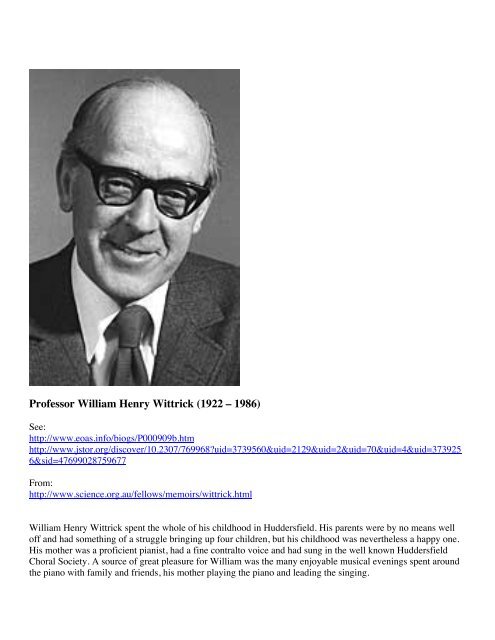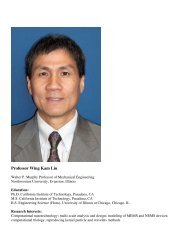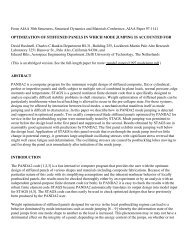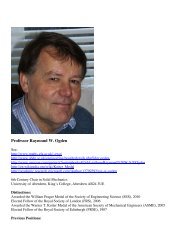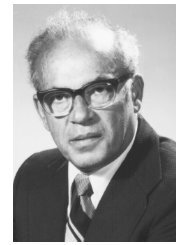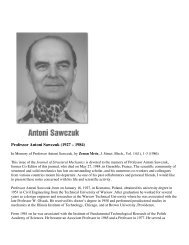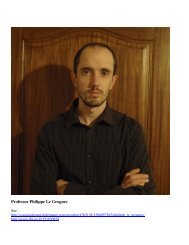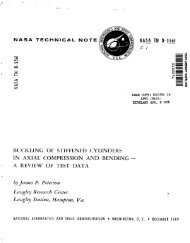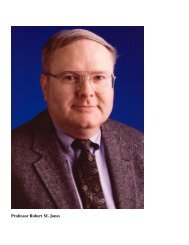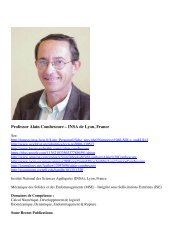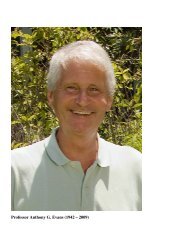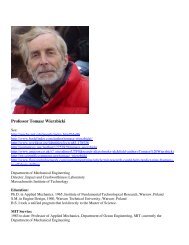Prof. W. H. Wittrick - Shell Buckling
Prof. W. H. Wittrick - Shell Buckling
Prof. W. H. Wittrick - Shell Buckling
You also want an ePaper? Increase the reach of your titles
YUMPU automatically turns print PDFs into web optimized ePapers that Google loves.
and active part in all aspects of university life and was currently Dean of the Faculty of Engineering. Hisacceptance of the chair of structural engineering at the University of Birmingham was a matter of great regret.Yet Bill, Joyce, Jane and Ann - as the family were affectionately known - left Australia with the sincere goodwishes of friends, colleagues and students alike.Birmingham University (1964-1982)After going to Birmingham University in October 1964, the main thrust of <strong>Wittrick</strong>'s research was to provideaerospace designers with the means of calculating, accurately and efficiently, the buckling loads or naturalfrequencies of vibration, together with the associated modes, of thin prismatic structures, the individual walls ofwhich are subjected to uniform biaxial compression and shear and may have either isotropic (metal) oranisotropic (composite) elastic properties.The work started in a fairly small way from an idea <strong>Wittrick</strong> had in 1965 for extending the EngineeringSciences Data Unit - Structures Data Sheets on the local (i.e. short wavelength) buckling of stiffened isotropicpanels to cope with loading cases in which the individual flats carry shear in addition to longitudinalcompression. The wavelength was supposed to be sufficiently small compared with the panel length for endeffects to be ignored, so that the panel could be considered to be effectively of infinite length. It was assumedthat the longitudinal line junctions between adjoining flats remained straight during buckling, but that rotationsoccurred about them. The fact that the nodal lines in the flats are curved in the presence of shear loading,resulting in (spatial) phase differences between the sinusoidally varying rotations about the various junctions,was allowed for by introducing complex vectors of rotations and the concept of complex 'stability functions'.The stiffness matrices turned out to be complex Hermitian. This work was done in conjunction with a Ph.D.student, P.L.V. Curzon, and resulted in four joint papers published in 1968 and 1969.<strong>Wittrick</strong> quickly realised that the approach could be generalised to include all possible forms of buckling in aunified way, provided that the prevailing conditions were such that all modes were sinusoidal or nearly so. Thatis the case if the stresses in the flats are invariant in the longitudinal direction, and either the ratio of halfwavelengthto the panel length is small enough for end effects to be unimportant or (in the absence of shearloading) the ends of the panel are 'diaphragm supported'. In general the longitudinal line junctions no longerremain straight during buckling and each one has four (complex) degrees of freedom associated with it,consisting of three translations plus one rotation. In order to cater for the destabilising effect of the membraneloading in the flats on in-plane deformations (which is necessary, for example, in the case of a web of a stiffenerin an overall mode, or a flange of a stiffener in a torsional mode), it was necessary to base the equations ofequilibrium of the theory of elasticity on the geometry of a deformed element. The analytical basis is providedin 'A unified approach to the initial buckling of stiffened panels in compression', Aeronautical Quarterly, 19(1968), 265-283, for calculating the buckling loads of panels under uniform longitudinal compression. This wasextended in 'General sinusoidal stiffness matrices for buckling and vibration analyses of thin flat-walledstructures', Int. J. Mech. Sci., 10 (1958), 949-966, to include more complicated load systems, with each flatsubjected to biaxial compression and shear. Moreover, by permitting all forces and displacements to varysinusoidally with time, the analysis also opened up the possibility of calculating either the critical bucklingloads (corresponding to zero frequency) or the natural frequencies and modes of a loaded panel, within a singlecomputer program.The one big problem remaining, before the by now large body of theory could be incorporated into a generalpurposecomputer program for use by designers, was how to extract the eigenvalues, i.e. the critical loads or
natural frequencies. Because the stiffness matrices are derived from exact solutions of the partial differentialequations, the elements of the overall stiffness matrix (the singularity of which provides the criterion forcalculating the eigenvalues) are transcendental functions of the eigenvalues and not linear ones as in aconventional (approximate) finite-element solution. The only known method of solution at that time was by trialand error, based upon the value of the determinant. For many reasons this is both unreliable and inefficient.First, it is all too easy to miss eigenvalues in the event of coincident or nearly coincident ones; secondly, it isimpossible to know a priori how small to make the load (or frequency) increment in the trial and error process;thirdly, the determinant may change sign via infinity as well as via zero; fourthly, such infinities in exceptionalcases coincide with each other and with zeros; and finally such methods are extremely difficult to incorporateinto a general-purpose program.It took several years to overcome this problem but, in the end, F.W. Williams and <strong>Wittrick</strong> developed anextension of the Sturm sequence procedure. In both buckling and vibration problems it enables the number ofeigenvalues lying between zero and any chosen value to be calculated with ease and provides a safe, reliableand efficient algorithm for general-purpose programs. The algorithm was first published in the context ofvibration of skeletal frames and then of any linearly elastic structure but was also extended to apply to thebuckling problem. It should be noted that in the latter problem, unlike the vibration one, both positive andnegative eigenvalues can occur in general. The algorithm also provides a straightforward exact means ofassembling the structure from substructures which may themselves be assembled from smaller substructuresand so on to any depth, thereby enabling the maximum possible advantage to be taken of any repetition as isusual in stiffened panels (e.g. identical and equally-spaced stiffeners). The algorithm has found manyapplications and was developed further to cover vibration of spinning bodies.Finally the whole analysis was further extended to include anisotropy of the individual flats, such as occurs incomposite structures. It was assumed that there is no interaction between bending and membrane forces anddeformations (i.e. symmetric lay-ups) and that the membrane properties are orthotropic (i.e. equal numbers ofplies in the +0 and -0 directions). The bending properties were taken to be fully anisotropic, includinginteraction between bending and twist.The later stages of development of all this theory, and its incorporation into the general-purpose computerprogram called VIPASA (Vibration and Instability of Plate Assemblies with Shear and Anisotropy), was carriedout under a research contract supervised by Dr. F.W. Williams (later <strong>Prof</strong>essor of Civil Engineering, UWIST,Cardiff). The program was commissioned during 1972 and handed over to the Royal Aircraft Establishment andthe aerospace industry.Following a joint paper about this work that was presented at an IUTAM Symposium at Harvard in 1974, theprogram was extensively tested by NASA and subsequently made available to all the major aerospaceorganisations in the USA and Britain. It has been used on numerous design projects and was immediatelychosen by NASA for checking the design of the Space Shuttle. In the latter role it correctly predicted a type ofbuckling failure that had been missed in the design stages and was only found during test.<strong>Wittrick</strong>'s plate and eigenvalue work led more or less directly to many other papers. However, his interests weremuch broader than this and led to significant contributions in other areas.<strong>Wittrick</strong>'s work on the stability of plates opened up the possibility of a better understanding and the solution of anumber of structural problems in civil engineering. These have been examined by research workers in various
countries. In Australia, use has been made of <strong>Wittrick</strong>'s analyses by N.W. Murray (professor of civilengineering at Monash University) to obtain theoretical results for comparison with some careful experimentalstudies of the influence of initial imperfections on the buckling loads of steel plates. The treatment described by<strong>Wittrick</strong> is an exact solution and was later followed up by an alternative semi-analytical finite-strip method. Thelatter has been extended by G.J. Hancock (associate professor of civil engineering at the University of Sydney)to interpret the behaviour of steel I-beams fabricated from steel plate when subject to local, distortional andlateral buckling.RetirementFor a number of years <strong>Wittrick</strong> suffered increasingly from breathlessness. This became much worse in 1979,when it was diagnosed as the restrictive airways disease emphysema. Thereafter he regularly used inhalers toalleviate - but not cure - the condition, but his activities were severely restricted as a result. In addition he feltincreasingly out of place as head of a fairly large department of civil engineering because his research interests,as well as most of his close professional contacts, were predominantly in the aeronautical field. Further, in viewof the increasing pressure upon university engineering departments to develop closer ties with industry and toturn out graduates supposedly more useful to industry, <strong>Wittrick</strong> felt more and more that he should make the wayclear for the University to replace him with someone more strongly in sympathy with these views and morecommitted to civil engineering. The University agreed to his request in February 1980 that he be allowed tostand down from the headship of the department (to which he had been appointed as a permanent position)whilst still retaining his chair. <strong>Wittrick</strong> then applied for, and was granted, three months' sabbatical leave later inthe year in order that he should not appear to be 'breathing down the neck' of his successor, friend and colleagueMichael Hamlin when he assumed office in September.When in 1980 <strong>Wittrick</strong> retired from his position as Beale <strong>Prof</strong>essor in the Department of Civil Engineering atBirmingham, his colleagues working in his own particular area of technical interest wished to mark the occasionby providing some form of permanent record in his honour. This took the form of a book comprisingcontributions from some of his many friends and colleagues in the field of structural mechanics. Appropriately,the volume was published by the Oxford University Press with which <strong>Wittrick</strong> had had a long association, notleast as one of the editors of the Oxford Engineering Science series.Early in 1982, <strong>Wittrick</strong> decided to retire at the age of 60, partly because his illness was making it increasinglyburdensome for him to carry out his professional duties, partly because of the financial squeeze that was by thencausing all British universities to encourage early retirement. He was elected Emeritus <strong>Prof</strong>essor and was giventhe use of a small office in the Department of Civil Engineering which he valued greatly, going to Birminghamfor one day in most weeks. This enabled him to continue to do some research, and to have the stimulus oftalking to colleagues with interests similar to his own. The standard of his contributions did not decline afterretirement nor did their quantity reduce very much. His mind was as alert as ever and the pleasure of hiscompany was only qualified by sadness at the trying physical restrictions caused by emphysema that he borewith great patience but which were too obvious for him to hide, even though by nature he would have wished todo so. He died on 2 July 1986.Australian friends and colleagues will remember Bill <strong>Wittrick</strong> as a man of cheerful disposition and a great senseof fun that he sometimes allowed to disguise his considerable intellectual qualities. Even so he was by nature aquiet man with the ability to derive great satisfaction from the simpler things of life. He and his charming wifeand their two daughters were an ideal family; Bill and Joyce never allowed their own activities to detract from
the care and concern they had for the well-being and education of their children. They made many friends andtheir friendship had about it a constant and enduring quality; and when they returned to England those friendswhen travelling overseas would always be sure of a warm welcome at the <strong>Wittrick</strong> home.To Bill, research was a very important part of his life; he gained immense satisfaction from developingmathematics to reveal the complex modes of behaviour of metal structures. He had a great respect for the powerof mathematical analysis and an equal regard for clear definition of the mechanics of the problems he chose tostudy. He had the gift of exceptionally clear exposition, evident in all his writing, teaching and supervision ofresearch.He was especially interested in the part that skill and craftsmanship play in producing the beautiful things withwhich we like to surround ourselves. He had himself acquired considerable skill in the use of woodworkingtools and he took much pleasure in making many fine pieces of furniture, some entirely to his own design. Inlater years he turned his attention to bookbinding and there exist some particularly elegant examples of hiswork.The image of the man comes more clearly into focus in the following personal reflections of a few of those whohad the privilege of working closely with him.<strong>Prof</strong>essor G.A.O. Davies writes:In 1959, as a young engineer in the Advanced Projects Office at British Aerospace Filton, I knew of Bill<strong>Wittrick</strong> as a very useful reference for certain plate buckling problems and when I was offered the opportunityto join him at the University of Sydney I looked forward to meeting a scientist and a scholar. I was notdisappointed.The Department of Aeronautics in Sydney was small even though it was the only such Department ofAeronautics in Australia. Some thirty third- and fourth-year undergraduates, with a handful of postgraduates,meant that the teaching and research load could be adequately managed by the Head of the Department(<strong>Prof</strong>essor <strong>Wittrick</strong>), the Reader - P.T. Fink (later Chief Scientist, Department of Defence, Australia), a SeniorLecturer - J.J. Mahony (later <strong>Prof</strong>essor of Applied Mathematics at the University of Western Australia) andmyself. Such a small department meant that the staff knew all students intimately and vice-versa, so theopportunity to foster young research talent and watch it mature was an experience few enjoy today. Bill<strong>Wittrick</strong> clearly enjoyed this role and commanded always the affection and loyalty of all undergraduates andresearch students.In the early sixties his work on swept-wing structures, on stress concentrations around holes in shells, and hisearly excursions into plate bending led him naturally to the infant digital computer. His enthusiasm was notblinkered, however, and he was still producing elegant analytical solutions. When he returned to England afternearly twenty years at Sydney University he left behind hundreds of graduates and postgraduates whoremember an enthusiast with the ability to communicate, a researcher full of ideas and eager to share and ascholar whose papers were a model of lucidity. His many academic colleagues and students counted him as afriend. He was always direct and never oblique. Above all he was a gentleman in both senses. In the past 26years that I have known him I never once heard an unkind word spoken of him, he enjoyed a unique mixture ofrespect and affection. His many papers are a fitting memorial to his scholarship, but his enthusiasm, industry,
loyalty and sense of fun remain embedded in the memories of his colleagues, co-workers, and students in theUnited Kingdom and in Australia.<strong>Prof</strong>essor F.W. Williams has said:Shortly after my move to Birmingham in 1967 Bill invited me to work with him to develop computer programswhich were the fore-runners of the later VIPASA. Then I quickly experienced a sense of privilege, respect andeven awe, which I think was probably typical of all Bill's junior co-workers. His courtesy and consideration wasunfailing. An abiding memory is the way he would identify and remove one's areas of ignorance. He wouldascertain that a particular point, or a whole area of work, was outside one's experience in a way which wasdirect but never crushing. Then he would pick up his fountain pen (never a biro!) and write rapidly, in bold andclear script, an explanation the lucidity of which is rarely matched even in lectures which have taken hours toprepare. I soon formed a strong image of our relationship as that of a craftsman and his apprentice, and Bill, likethe best of master craftsmen, passed on by example and training the very highest standards of scholarlyintegrity, enthusiasm and thoroughness.Associate <strong>Prof</strong>essor G.J. Hancock writes:In 1978 I published a paper on the local, distortional and lateral buckling of I-beams using the semi-analyticalfinite strip method of Plank and <strong>Wittrick</strong>. When I arrived in Birmingham in October 1978 to spend six monthssabbatical leave working with <strong>Prof</strong>essor <strong>Wittrick</strong>, the first question he asked me was why I had chosen thesemi-analytical method in preference to his earlier published exact method. It became clear from our subsequentdiscussions that although he had been a major contributor to the former method his heart lay with the latter.The main purpose of my work at Birmingham was to develop a non-linear analysis of plates in the postbucklingrange, using the semi-analytical finite strip method, a task in which I received from <strong>Prof</strong>essor <strong>Wittrick</strong>maximum support both financial and intellectual. We met at regular intervals when he would listen to asummary of what I had been doing and then give me a set of references from which he thought I might clarifysome of my difficulties and misunderstandings. I look back on those sessions as one of the most stimulatingperiods of my career.The semi-analytical method continues to be developed by other research workers including <strong>Prof</strong>essor Murray atMonash University, <strong>Prof</strong>essor Sridharan at Washington University and at Sydney University to include materialplasticity and to demonstrate the advantages of incorporating the spline finite strip method. <strong>Prof</strong>essor <strong>Wittrick</strong>took a keen interest in all this work and communicated with me regularly right up to the time of his death.AcknowledgementsI wish to thank all those who by formal and informal contributions have assisted in the writing of this memoir. Iam especially grateful for helpful correspondence with Mrs. Joyce <strong>Wittrick</strong>. I am indebted to the University ofSydney for access to certain records and to Dr. E.H. Mansfield, FRS, for detailed information about <strong>Wittrick</strong>'swork after 1964. Special thanks are also due to <strong>Prof</strong>essor G.A.O. Davies for his several contributions, to<strong>Prof</strong>essor F.W. Williams and to Associate <strong>Prof</strong>essor G.J. Hancock.Academic and <strong>Prof</strong>essional qualifications:M.A. (Master of Arts, University of Cambridge, 1947)
direction. During buckling or vibration, the edges of any individual plate are subjected to additional systems offorces and moments which are sinusoidally distributed along the edges, and these give rise to sinusoidallyvarying edge displacements and rotations. Spatial phase differences between the forces and displacements areaccounted for by defining them in terms of complex quantities. The sinusoidal edge forces and displacementsare split into two uncoupled systems, corresponding to out-of-plane and in-plane displacements, and twostiffness matrices are defined. The out-of-plane stiffness matrix is shown to be in general complex, andHermitian in form, but the inplane stiffness matrix is real and symmetrical. Explicit expressions are derived forthe elements of the matrices, in which all the essential destabilizing effects of the basic stresses, as well asdynamic effects, are included. Finally, it is shown that buckling and vibration phenomena for any structure ofthis type are closely interrelated.<strong>Wittrick</strong>, W. H., "A Unified Approach to the Initial <strong>Buckling</strong> of Stiffened Panels in Compression," TheAeronautical Quarterly, Aug. 1968, pp. 265-283.Williams, F. W. and <strong>Wittrick</strong>, W. H. Computational procedures for a matrix analysis of the stability andvibration of thin flat-walled structures in compression. Int. J. Mech. Sci., 1969, 11(12), 979-998.<strong>Wittrick</strong>, W. H. and Williams, F.W. A general algorithm for computing natural frequencies of elastic structures.Q. J. Mech. Appl. Math., 1971, 24(3), 263-284.W.H. <strong>Wittrick</strong> (Department of Civil Engineering, University of Birmingham, Birmingham 15 UK), “On thelocal buckling of truss-type corrugated-core sandwich panels in compression”, International Journal ofMechanical Sciences, Vol. 14, No. 4, April 1972, pp. 263-264, doi:10.1016/0020-7403(72)90067-7ABSTRACT: A theoretical analysis of the local buckling of corrugated-core sandwich panels with truss-type(i.e. triangular) corrugations in compression is developed. It has the unusual feature that the nodal lines of thebuckling mode are not assumed to be straight and perpendicular to the direction of compression. Such modesare found to correspond to slightly lower buckling stresses than the usual type, for panels with a wide range ofgeometries. The existence of modes of this type has been observed experimentally.<strong>Wittrick</strong>, W. H. and Williams, F. W. An algorithm for computing critical buckling loads of elastic structures. J.Struct. Mech., 1973, 1(4), 497-518.W. H. <strong>Wittrick</strong> and F. W. Williams (Department of Civil Engineering, University of Birmingham, Edgbaston,Birmingham, England), “<strong>Buckling</strong> and vibration of anisotropic or isotropic plate assemblies under combinedloadings”, International Journal of Mechanical Sciences, Vol. 16, No. 4, April 1974, pp. 209-239,doi:10.1016/0020-7403(74)90069-1ABSTRACT: This paper describes the underlying theory, and a general-purpose computer program, VIPASA,for determining the critical buckling stresses or natural frequencies of vibration of thin prismatic structures,consisting of a series of plates rigidly connected together along longitudinal edges. Each plate may be eitherisotropic or anisotropic and may carry a basic stress system consisting of longitudinal and transverse directstress combined with shear. The structure is assumed to be subjected to a “dead load” system which does notcause buckling; in addition a “live load” system, defined in magnitude by a single load factor, may be appliedand the value of the load factor at buckling is determined. Alternatively the natural frequencies of vibration ofthe structure when subjected to the dead load system are determined. Any number of critical load factors ornatural frequencies can be obtained. The theory is based upon the assumption that all modes are sinusoidal, inthe sense that all three components of displacement vary sinusoidally along any longitudinal line, but phasedifferences are incorporated to allow for the effects of anisotropy and shear. Apart from this assumption no
further approximations are made other than those inherent in thin plate theory.Plank, R. J. and <strong>Wittrick</strong>, W. H. <strong>Buckling</strong> under combined loading of thin, flat-walled structures by a complexfinite strip method. Int. J. Numer. Methods Eng., 1974, 8(2),323-339.Williams, F.W., <strong>Wittrick</strong>, W.H. and Plank, R.J., “Critical buckling loads of some prismatic plate assemblies”,Proc. IUTAM Symposium on <strong>Buckling</strong> of Structures, 1974, edited by B. Budiansky, Springer-Verlag, pp. 17-26, (1976)


